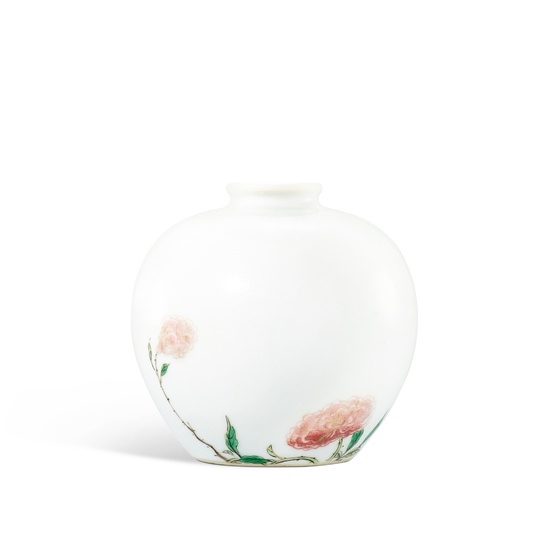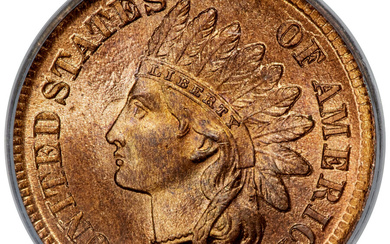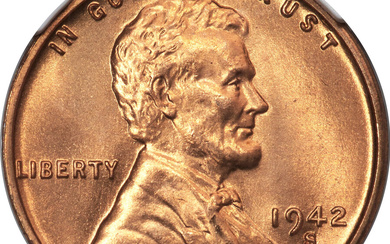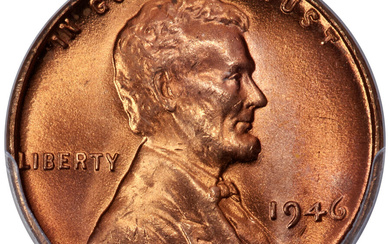A rare and exceptional copper-red and famille-verte 'rose' vase, Mark and period of Kangxi | 清康熙 五彩釉裏紅玫瑰紋蘋果尊 《大清康熙年製》款
A rare and exceptional copper-red and famille-verte 'rose' vase,
Mark and period of Kangxi
清康熙 五彩釉裏紅玫瑰紋蘋果尊 《大清康熙年製》款
elegantly potted with a globular body rising to a short waisted neck and everted rim, delicately painted with a pair of lush flowering rose branches rising from the base, each bearing two copper-red blossoms in strawberry-red tones, one partially open and the other in full bloom, the aubergine stems and leaves of varying green elegantly outlined in black, the recessed base inscribed in underglaze blue with a six-character mark in three columns
h. 8.5 cm
Condition Report:
The vase is in very good overall condition with just a minute approx. 0.2 cm flake to the rim.
整體品相良好,僅口沿見一處約0.2公分淺剝痕。
Catalogue Note:
Exquisitely potted and sparingly painted with a serene design of two rose sprays, this rare vessel highlights the technical progress achieved by craftsmen under the visionary Kangxi Emperor, one of China’s greatest rulers. Despite coming to the throne at a young age, he realized that to gain and retain the respect necessary to rule over a predominantly Han-Chinese elite, he had to be exemplary in his knowledge as well as his deeds. Thus, he devoted himself to learning and understanding China’s history, culture and achievements in the natural sciences. In doing so, he revived industries and workshops that had laid stagnant for nearly sixty years with traditional and innovative technologies. The Emperor’s principal aim appears to have been to regain standards of quality that had long been lost, and to employ ancient techniques in a new way.
The imperial kilns at Jingdezhen were one of the first workshops the Kangxi Emperor restored, and one of the techniques revisited in particular was the use of copper-red pigment. Notoriously difficult to control, the pigment had hardly been used since the outstanding results achieved in the Xuande period. The present piece displays the level of skill that was gained in the masterfully controlled pencil lines and shading of the roses.
The tasteful restraint of the present design suggests that it is a product of Liu Yuan (c.1638-c.1685), a gifted painter the Kangxi Emperor engaged to create new porcelain designs. This approach of involving a designer was highly unusual at the time and resulted in a new departure for porcelain decoration, with the designs drawing on both ancient and modern forms. One innovation was the predominant use of blank white space, which is reminiscent of album-leaf paintings. The combination of soft copper red with the minimal use of overglaze black and green emphasize the delicacy of the subject in a manner that would have appealed to the elite.
The present design is known in two similar versions, with the bud to the left or right of the main bloom. A very similar design also exclusively appears on one form of waterpot, where the buds or blooms can be painted in overglaze iron-red and occasionally other enamels. A closely related vessel in the Palace Museum, Beijing, is published together with a matching waterpot in Kangxi. Yongzheng. Qianlong. Qing Porcelain from the Palace Museum Collection, Hong Kong, 1989, pls 24-25; and another set is illustrated in John Ayers, Chinese Ceramics in the Baur Collection, Geneva, 1999, vol. 2, pls 148 and 149.
Vessels of this type are also in the Sir Percival David Collection, now in the British Museum, London, published in the Illustrated Catalogue of Ming and Ming Style Polychrome Wares in the Percival David Foundation of Chinese Art, London, 2006, pl. B 702; and in the Asian Art Museum of San Francisco, included in He Li, Chinese Ceramics. A New Standard Guide, London, 1996, pl. 579. See also a similar example, from the Meiyintang Collection and published in Regina Krahl, Chinese Ceramics from the Meiyintang Collection, vol. 2, London, 1994, pl. 737, sold in our Hong Kong rooms, 7th April 2011, lot 2; another from the Edward T. Chow Collection, sold twice in our Hong Kong rooms, 18th May 1981, lot 539, and again 28th April 1992, lot 158; and a further example sold in our New York rooms, 22nd September 2020, lot 114.
本品器形秀美,紋飾素雅,繪玫瑰兩枝,展示康熙年間藝匠非凡成就。康熙雖年少登基,卻深知如欲得漢族菁英臣服,必須才德兼備,故此潛心研究中國歷史文化,以及科學成就,從中又復興工、藝,令其沉寂近六十年後再現神采,既遵循傳統,同時加入創新技術。
首先復興者,乃景德鎮御窰。銅紅嬌溫,極難控制,自宣德年製成精品後幾近絕跡,康熙年間,景德鎮御窰再度燒製銅紅釉器,成就為後人稱頌,本品紋飾精巧,更可展示藝匠控制紋飾線條、花紋明暗效果之技藝。
本品紋飾素雅,樣稿或出自康熙年間瓷器畫師劉源(約1638-約1685年)手筆。派遣畫師構思瓷器紋飾,於當時甚為罕見,此舉為瓷器紋飾注入新穎創思,所成紋飾參考古今設計,美學風格獨具時代特色,其中一項特點,乃仿效書畫留白背景,而本品以柔和釉裏紅為主,輔以釉上黑彩及綠彩點睛,更顯花兒纖巧,風格符合當時菁英品味。
本式紋樣可見兩款,花苞置於主花左或右側。此類紋飾亦見於另一器形之水丞,其飾或以礬紅彩繪成,亦偶施其它彩料。北京故宮博物院收藏一例,與一水丞例同載於《故宮珍藏康雍乾瓷器圖錄》,香港,1989年,圖版24及25;另一例圖載於約翰.艾爾斯,《Chinese Ceramics in the Baur Collection》,日內瓦, 1999年,卷2,圖版148及149。
與此器同款之例,可參考大維德爵士舊藏,現存於倫敦大英博物館,載於《Illustrated Catalogue of Ming and Ming Style Polychrome Wares in the Percival David Foundation of Chinese Art》,倫敦,2006年,圖版B702;另一例藏於洛杉磯亞洲藝術博物館,收入賀利,《Chinese Ceramics. A New Standard...
View it on
Sale price
Estimate
Reserve
Time, Location
Auction House
A rare and exceptional copper-red and famille-verte 'rose' vase,
Mark and period of Kangxi
清康熙 五彩釉裏紅玫瑰紋蘋果尊 《大清康熙年製》款
elegantly potted with a globular body rising to a short waisted neck and everted rim, delicately painted with a pair of lush flowering rose branches rising from the base, each bearing two copper-red blossoms in strawberry-red tones, one partially open and the other in full bloom, the aubergine stems and leaves of varying green elegantly outlined in black, the recessed base inscribed in underglaze blue with a six-character mark in three columns
h. 8.5 cm
Condition Report:
The vase is in very good overall condition with just a minute approx. 0.2 cm flake to the rim.
整體品相良好,僅口沿見一處約0.2公分淺剝痕。
Catalogue Note:
Exquisitely potted and sparingly painted with a serene design of two rose sprays, this rare vessel highlights the technical progress achieved by craftsmen under the visionary Kangxi Emperor, one of China’s greatest rulers. Despite coming to the throne at a young age, he realized that to gain and retain the respect necessary to rule over a predominantly Han-Chinese elite, he had to be exemplary in his knowledge as well as his deeds. Thus, he devoted himself to learning and understanding China’s history, culture and achievements in the natural sciences. In doing so, he revived industries and workshops that had laid stagnant for nearly sixty years with traditional and innovative technologies. The Emperor’s principal aim appears to have been to regain standards of quality that had long been lost, and to employ ancient techniques in a new way.
The imperial kilns at Jingdezhen were one of the first workshops the Kangxi Emperor restored, and one of the techniques revisited in particular was the use of copper-red pigment. Notoriously difficult to control, the pigment had hardly been used since the outstanding results achieved in the Xuande period. The present piece displays the level of skill that was gained in the masterfully controlled pencil lines and shading of the roses.
The tasteful restraint of the present design suggests that it is a product of Liu Yuan (c.1638-c.1685), a gifted painter the Kangxi Emperor engaged to create new porcelain designs. This approach of involving a designer was highly unusual at the time and resulted in a new departure for porcelain decoration, with the designs drawing on both ancient and modern forms. One innovation was the predominant use of blank white space, which is reminiscent of album-leaf paintings. The combination of soft copper red with the minimal use of overglaze black and green emphasize the delicacy of the subject in a manner that would have appealed to the elite.
The present design is known in two similar versions, with the bud to the left or right of the main bloom. A very similar design also exclusively appears on one form of waterpot, where the buds or blooms can be painted in overglaze iron-red and occasionally other enamels. A closely related vessel in the Palace Museum, Beijing, is published together with a matching waterpot in Kangxi. Yongzheng. Qianlong. Qing Porcelain from the Palace Museum Collection, Hong Kong, 1989, pls 24-25; and another set is illustrated in John Ayers, Chinese Ceramics in the Baur Collection, Geneva, 1999, vol. 2, pls 148 and 149.
Vessels of this type are also in the Sir Percival David Collection, now in the British Museum, London, published in the Illustrated Catalogue of Ming and Ming Style Polychrome Wares in the Percival David Foundation of Chinese Art, London, 2006, pl. B 702; and in the Asian Art Museum of San Francisco, included in He Li, Chinese Ceramics. A New Standard Guide, London, 1996, pl. 579. See also a similar example, from the Meiyintang Collection and published in Regina Krahl, Chinese Ceramics from the Meiyintang Collection, vol. 2, London, 1994, pl. 737, sold in our Hong Kong rooms, 7th April 2011, lot 2; another from the Edward T. Chow Collection, sold twice in our Hong Kong rooms, 18th May 1981, lot 539, and again 28th April 1992, lot 158; and a further example sold in our New York rooms, 22nd September 2020, lot 114.
本品器形秀美,紋飾素雅,繪玫瑰兩枝,展示康熙年間藝匠非凡成就。康熙雖年少登基,卻深知如欲得漢族菁英臣服,必須才德兼備,故此潛心研究中國歷史文化,以及科學成就,從中又復興工、藝,令其沉寂近六十年後再現神采,既遵循傳統,同時加入創新技術。
首先復興者,乃景德鎮御窰。銅紅嬌溫,極難控制,自宣德年製成精品後幾近絕跡,康熙年間,景德鎮御窰再度燒製銅紅釉器,成就為後人稱頌,本品紋飾精巧,更可展示藝匠控制紋飾線條、花紋明暗效果之技藝。
本品紋飾素雅,樣稿或出自康熙年間瓷器畫師劉源(約1638-約1685年)手筆。派遣畫師構思瓷器紋飾,於當時甚為罕見,此舉為瓷器紋飾注入新穎創思,所成紋飾參考古今設計,美學風格獨具時代特色,其中一項特點,乃仿效書畫留白背景,而本品以柔和釉裏紅為主,輔以釉上黑彩及綠彩點睛,更顯花兒纖巧,風格符合當時菁英品味。
本式紋樣可見兩款,花苞置於主花左或右側。此類紋飾亦見於另一器形之水丞,其飾或以礬紅彩繪成,亦偶施其它彩料。北京故宮博物院收藏一例,與一水丞例同載於《故宮珍藏康雍乾瓷器圖錄》,香港,1989年,圖版24及25;另一例圖載於約翰.艾爾斯,《Chinese Ceramics in the Baur Collection》,日內瓦, 1999年,卷2,圖版148及149。
與此器同款之例,可參考大維德爵士舊藏,現存於倫敦大英博物館,載於《Illustrated Catalogue of Ming and Ming Style Polychrome Wares in the Percival David Foundation of Chinese Art》,倫敦,2006年,圖版B702;另一例藏於洛杉磯亞洲藝術博物館,收入賀利,《Chinese Ceramics. A New Standard...






